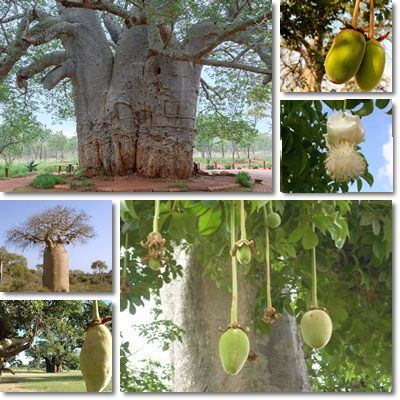Native to the African savanna and shrubland, baobab trees (Adansonia digitata) are a memorable sight due to their monumental sizes and rememberable appearance. Their fruit stir even more attention in that they aid with liver detoxification, improve immunity and boost energy levels greatly. Baobabs are those solitary, massive trees that you see on the horizon of any African savanna picture.
They stand tall and alone and prompt us to label them as a display of history.
Many specimens of Adansonia digitata are now protected by law and serve as landmarks celebrating the species’ extreme longevity. Specialists estimate that many individuals can easily reach a thousand years of age, if left alone to do what they do best: survive. Although they are native to Africa, specimens have been introduced to other arid regions of the planet in the hope that others may enjoy their absorbing beauty as well as health benefits.

What do baobab trees look like?
Baobabs are massive, solitary trees growing in the African savannah. The Adansonia digitata species reaches about 25 meters in height and about 15 meters in girth, making it quite a magnetic sight. Unlike other trees, baobabs are leafless about 9 months a year and have quite a stout crown with thick, yet sparse branches that look more like roots, hence the name upside-down tree. The species has a fine, reddish brown, sometimes gray bark and enormous, drooping five-petaled white flowers that only live for about 24 hours.
What do baobab flowers look like?
The flowers of the Adansonia digitata species have leathery, crinkled petals with dangling stamens resembling hairy puff balls. Both the flowers and the fruit of this species are suspended on long stalks. Flowers bloom for only 24 hours at the end of the dry season. Other baobab species have more colorful flowers, with various dotted patterns and bright pink, yellow and red petals.
What does a baobab fruit look like?
Baobab fruit are dangling, elongated, often pointy pod-like fruit that reach 25 cm in length. They have a hard green-gray outer shell and a creamy white pulp full of seeds. When the fruit ripens, its pulp dries and hardens and ends up looking like small chunks of stale flour.
What does a baobab fruit taste like?
Baobab fruit have a tart, somewhat sour taste and a slightly gritty texture. The gritty texture is a result of the high fiber content of the fruit’s pulp. Baobab fruit can be consumed either fresh or soaked in water to make a sort of milk drink. The pulp, seeds and leaves are all edible. Seeds are usually crushed or ground, while younger, more tender leaves are often added to traditional local dishes. Since the fresh fruit are hard to find outside their area of growth, powder pulp is often the best you can get at your local supermarket.

What are the benefits of baobab fruit?
As a result of their extremely deep roots, baobab trees manage to extract all the nutrients they need from the arid African wilderness and thus provide extremely nutritious fruit that supply the local population with much-needed nutrients. Here are the most notable 5 nutrition facts and health benefits of the baobab fruit:
Rich in vitamin C
It is estimated that only 100 g of baobab fruit pulp contains up to 3 times more vitamin C than oranges, making it one of the foods richest in vitamin C. As you may already know, vitamin C is an extremely potent antioxidant with incredible free radical-scavenging properties. Numerous studies suggest a high intake can help prevent cardiovascular disease and even cancer. However, in order to enjoy a maximum intake of the vitamin, it is recommended to consume the fruit either fresh, or in powder form.
Good source of essential minerals
Both fresh baobab pulp and baobab fruit powder are a good source of essential dietary minerals such as calcium (295 mg), copper (1.6 mg), iron (9.3 mg), magnesium (90 mg), potassium (1240 mg) and zinc (2 mg). The minerals are responsible for thousands of chemical processes within our body and help ensure strong bones and teeth, maintain healthy eyes and hair, improve energy levels, regulate heart activity and blood pressure and boost immunity, to name a few.
Improves energy levels
The baobab fruit constitutes a complete and nutritious food, ideal for poor diets, lacking in essential nutrients. As a result of its high vitamin, mineral, carbohydrate and protein content, it manages to restore and improve energy levels, resulting in a good mood, increased resistance to both effort and stress.
Promotes liver detoxification
The thing baobab fruit are most famous for is their ability to cleanse the body of toxins by helping detoxify the liver. This is done firstly by ensuring a good nutrient intake to help the liver work as it should and do its job: eliminate toxins from the body. Secondly, baobab fruit pulp was found to contain triterpenoids, beta-sitosterol and ursolic acid which, according to research, may lend it strong hepatoprotective properties. These compounds are also being studied for their anticancer properties.
Exhibits anti-aging properties
Baobab fruit have great antioxidant value, most of which stems from their incredible vitamin C content. According to researchers, consuming the fruit on a regular basis triggers a sort of skin regeneration process brought on by an increase in collagen production. Collagen is essential not only for beautiful, firm, wrinkle-free skin, but also for maintaining the integrity of blood vessel walls, cartilages, tendons, ligaments and even muscles. Moreover, the high amounts of vitamin C in baobab fruit help scavenge harmful free radicals and prevent damage at cellular level.
Conclusion
Did you know that the second part of the Latin name of the Adansonia digitata baobab species is a result of the tree (usually) having five leaves resembling digits? Also, did you know that the reason why baobabs are such resilient and longevous trees is because they have roots going deeper in the ground than the entire height of the tree? Last but not least, did you know that baobab trees with massive trunks often served as shelter for both people and animals and, more recently, as pubs and historical landmarks for touristic purposes?
